Web Equipment, Naval, Pattern 1919 - Haversacks and Packs
Haversack
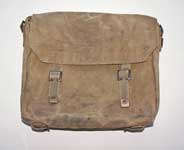
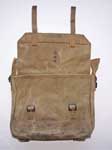

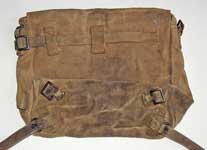 The Web Equipment, Naval, Pattern 1919 Haversack was introduced with the Pattern 1919 Naval Web Equipment in List of Changes entry L. of C. §23254, dated 2nd October 1919. Like the Pattern 1914 Haversack, it has a wedge shaped profile, tapering from 4-inches wide at the bottom to 2-inches at the top. It has the usual two 3/4-inch straps and chapes on the front and 1-inch chapes on the sides, but the other fittings are unique to this type. On the rear, there is a 3/4-inch strap that extend horizontally across the entire width, passing through two short vertical web loops and finally buckling to a short chape on the right side. When originally introduced, the Haversack was fitted with Patt. '08 style open bar Twigg buckles. The first issue example shown left is maker marked "M.E. Co." and dated 1920. It is from the John Lamont Collection, all photographs of this Haversack on this page are © John Lamont 2010.
The Web Equipment, Naval, Pattern 1919 Haversack was introduced with the Pattern 1919 Naval Web Equipment in List of Changes entry L. of C. §23254, dated 2nd October 1919. Like the Pattern 1914 Haversack, it has a wedge shaped profile, tapering from 4-inches wide at the bottom to 2-inches at the top. It has the usual two 3/4-inch straps and chapes on the front and 1-inch chapes on the sides, but the other fittings are unique to this type. On the rear, there is a 3/4-inch strap that extend horizontally across the entire width, passing through two short vertical web loops and finally buckling to a short chape on the right side. When originally introduced, the Haversack was fitted with Patt. '08 style open bar Twigg buckles. The first issue example shown left is maker marked "M.E. Co." and dated 1920. It is from the John Lamont Collection, all photographs of this Haversack on this page are © John Lamont 2010.
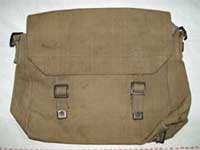

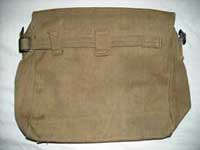 List of Changes entry L. of C. §23970, dated 11th March 1921, changed the buckle design to a closed bar buckle, creating a second issue of the Pattern 1919 Haversack. The second issue example shown in these pictures, maker marked "M.E. Co." and dated 1940, has the closed bar buckles. From the Karkee Web Collection.
List of Changes entry L. of C. §23970, dated 11th March 1921, changed the buckle design to a closed bar buckle, creating a second issue of the Pattern 1919 Haversack. The second issue example shown in these pictures, maker marked "M.E. Co." and dated 1940, has the closed bar buckles. From the Karkee Web Collection.

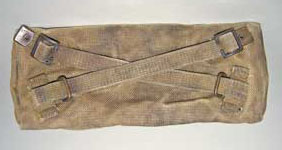
 Views of the bottom of the Haversack. The picture far left (the second issue example shown above) shows the buckles and loops that are used to store the Haversack straps when they not in use. Centre left, the first issue Haversack is shown with its Straps in place. Near left, a close-up detail of the connections.
Views of the bottom of the Haversack. The picture far left (the second issue example shown above) shows the buckles and loops that are used to store the Haversack straps when they not in use. Centre left, the first issue Haversack is shown with its Straps in place. Near left, a close-up detail of the connections.
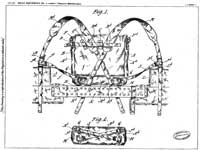
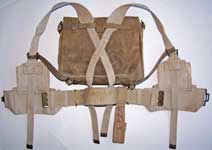 When the Haversack is carried on the back, the horizontal strap is passed behind the Braces above the cross-over loop. This holds the Haversack close against the back, while its weight is supported by the Haversack straps, which are looped around the Brace attachments (or the Cartridge carriers, in the Rifle Equipment) and buckled to the chapes on the bottom of the Haversack. The drawing far left is taken from the Mills Equipment Company Patent No. 117127, dated 5th July, 1918. Near left, a contemporary photo showing the same layout. These two pictures demonstrate how the Haversack is fitted and carried. Note how the Haversack straps are passed around the Brace just above the Cartridge carriers, and connect to the buckles on the bottom of the Haversack. Also note the way in which the Braces are held against the top of the Haversack by a horizontal strap, but are not actually connected to it. These features, unique to Pattern 1919, ensure that the weight of the Haversack is taken by the Straps and distributed to the sides, not by the Braces, where it would cause them to pull up in front. This guarantees that the load is properly balanced. This is an improvement over the Pattern 1908 design. In that design, the weight of the Pack or Haversack was intended to be taken by the diagonal straps attached to the Cartridge carriers. It proved all too easy, though, for "military appearance" to take precedence over design, and the Pack was often worn too high on the back, so that its weight was taken by the Braces. With this design, that cannot happen. This very real design improvement was overtaken by other events, though, and was never used again.
When the Haversack is carried on the back, the horizontal strap is passed behind the Braces above the cross-over loop. This holds the Haversack close against the back, while its weight is supported by the Haversack straps, which are looped around the Brace attachments (or the Cartridge carriers, in the Rifle Equipment) and buckled to the chapes on the bottom of the Haversack. The drawing far left is taken from the Mills Equipment Company Patent No. 117127, dated 5th July, 1918. Near left, a contemporary photo showing the same layout. These two pictures demonstrate how the Haversack is fitted and carried. Note how the Haversack straps are passed around the Brace just above the Cartridge carriers, and connect to the buckles on the bottom of the Haversack. Also note the way in which the Braces are held against the top of the Haversack by a horizontal strap, but are not actually connected to it. These features, unique to Pattern 1919, ensure that the weight of the Haversack is taken by the Straps and distributed to the sides, not by the Braces, where it would cause them to pull up in front. This guarantees that the load is properly balanced. This is an improvement over the Pattern 1908 design. In that design, the weight of the Pack or Haversack was intended to be taken by the diagonal straps attached to the Cartridge carriers. It proved all too easy, though, for "military appearance" to take precedence over design, and the Pack was often worn too high on the back, so that its weight was taken by the Braces. With this design, that cannot happen. This very real design improvement was overtaken by other events, though, and was never used again.
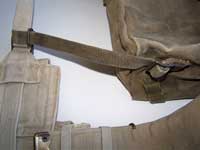
 Additional photos showing the Haversack in place. The equipment shown here left and above left is actually a set of the South African Braithwaite Pattern, except for the Patt. '19 Haversack and its Haversack straps. The Haversack can be fitted to this equipment just as it would be fitted to a set of W.E. Patt. '19 Rifle Equipment. In the Pattern 1919 Officers' Equipment or Naval Pistol Equipment, the Haversack straps would connect to the Haversack in the same way, but would be looped through the ring in the Brace attachments, instead of around the Brace itself. The equipment in these pictures is from the John Lamont Collection, and the photographs are © John Lamont 2010.
Additional photos showing the Haversack in place. The equipment shown here left and above left is actually a set of the South African Braithwaite Pattern, except for the Patt. '19 Haversack and its Haversack straps. The Haversack can be fitted to this equipment just as it would be fitted to a set of W.E. Patt. '19 Rifle Equipment. In the Pattern 1919 Officers' Equipment or Naval Pistol Equipment, the Haversack straps would connect to the Haversack in the same way, but would be looped through the ring in the Brace attachments, instead of around the Brace itself. The equipment in these pictures is from the John Lamont Collection, and the photographs are © John Lamont 2010.
Pack, 2nd issue
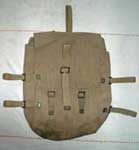
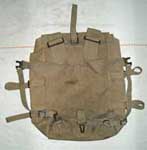
 The Web Equipment, Naval, Pattern 1919 Pack was introduced with the Pattern 1919 Naval Web Equipment in List of Changes entry L. of C. §23254, dated 2nd October 1919. Although the List of Changes used the term "Pack" for this piece of equipment, the Mills Company consistently referred to this design as a "Rucksack". M.E. Co. used this term when the Pack had integral shoulder straps with side straps and fittings to connect them to the Brace attachments or Cartridge carriers. It's worth noting, also, that whilst this was the first time that this form had been officially introduced into British service, it was hardly a new design. Early versions of the Mills Rucksack are known to exist dated as early as 1911. The Rucksack used for the Belgian M1915 Web Equipment, manufactured by the American Mills Woven Cartridge Belt Company, was identical to the first issue W.E. Patt. '19 Pack, and the Rucksack for the Mills Web Equipment, Officers, first introduced in 1917, differed from the Patt. '19 version only slightly.
The Web Equipment, Naval, Pattern 1919 Pack was introduced with the Pattern 1919 Naval Web Equipment in List of Changes entry L. of C. §23254, dated 2nd October 1919. Although the List of Changes used the term "Pack" for this piece of equipment, the Mills Company consistently referred to this design as a "Rucksack". M.E. Co. used this term when the Pack had integral shoulder straps with side straps and fittings to connect them to the Brace attachments or Cartridge carriers. It's worth noting, also, that whilst this was the first time that this form had been officially introduced into British service, it was hardly a new design. Early versions of the Mills Rucksack are known to exist dated as early as 1911. The Rucksack used for the Belgian M1915 Web Equipment, manufactured by the American Mills Woven Cartridge Belt Company, was identical to the first issue W.E. Patt. '19 Pack, and the Rucksack for the Mills Web Equipment, Officers, first introduced in 1917, differed from the Patt. '19 version only slightly.
The fittings on this Pack differ substantially from the Packs of the W.E. Pattern 1908 design lineage. In addition to the integral shoulder straps, side straps, and fittings mentioned above, these include five 3/4-inch straps and chapes - one on top and two on each side - to carry a rolled blanket and groundsheet, a 3/4-inch strap and chape on the front cover to carry the mess tin, and a 1 1/2-inch wide short strap on the bottom rear fitted with a "keyway" slotted buckle. This is a steadying strap that loops around the Waist belt and hooks to a stud on the bottom of the Pack. As with the Haversack, when it was originally introduced the Pack was fitted with Patt. '08 style open bar Twigg buckles. List of Changes entry L. of C. §23970, dated 11th March 1921, changed the buckle design to a closed bar buckle. This example shown above left, maker marked "M.E. Co." and dated 1940, has the closed bar buckles. From the Karkee Web Collection.
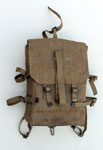

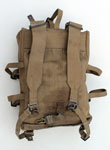
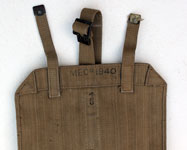 Another example of the 2nd issue Pack. This example is also M .E. Co. marked and dated 1940. This row, left to right: front, right side, rear, inner flap.
Another example of the 2nd issue Pack. This example is also M .E. Co. marked and dated 1940. This row, left to right: front, right side, rear, inner flap.
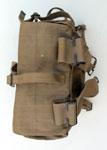


 Additional views, left to right: top, pack open, bottom 1, bottom 2. The last two views show how the slotted buckle fits on the stud on the bottom of the Pack. From the Jean Lummerzheim Collection, photos © Jean Lummerzheim 2012.
Additional views, left to right: top, pack open, bottom 1, bottom 2. The last two views show how the slotted buckle fits on the stud on the bottom of the Pack. From the Jean Lummerzheim Collection, photos © Jean Lummerzheim 2012.



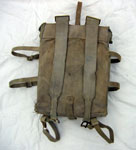 At first, this appears to be a 1st issue Patt. '19 Pack, albeit a quite worn one, and the mess tin strap on the flap has been replaced. When we saw the markings, though, the "bullet" logo and the 1916 date, we identified it as Belgian M1915 Web Equipment, manufactured by the American Mills Woven Cartridge Belt Company. However, when the owner pointed out the naval broad arrow over "N" inspection mark (which we'd missed the first time around, to be honest), we had another look. That certainly shouldn't be there, if it was Belgian!
At first, this appears to be a 1st issue Patt. '19 Pack, albeit a quite worn one, and the mess tin strap on the flap has been replaced. When we saw the markings, though, the "bullet" logo and the 1916 date, we identified it as Belgian M1915 Web Equipment, manufactured by the American Mills Woven Cartridge Belt Company. However, when the owner pointed out the naval broad arrow over "N" inspection mark (which we'd missed the first time around, to be honest), we had another look. That certainly shouldn't be there, if it was Belgian!
Of course, the mark could be a fake, added by an unscrupulous seller, but it's quite small and worn. It certainly looks pukkah to us. Would a forger out for profit be that subtle? And besides, what profit? M1915 equipment is avidly sought after by Belgian collectors, and sells for at least as much as Pattern 1919, so why bother?
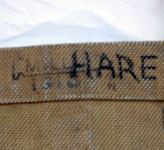 The assumption has always been that the "bullet" T.M. indicated that an article had been made by M.W.C.B.Co., fulfilling an order obtained by them, directly. It would not preclude geographically close Belgium, an ally of Britain, ordering from M.E.Co., with the latter sub-contracting the work to the former U.S. parent company. Deliveries would have been back to M.E.Co., for onward despatch to the Belgian Army, with M.E.Co. perhaps holding maintenance stocks. If such stocks remained un-used in 1919, they could of course have been added to the Royal Navy's order for Patt. '19 W.E.
The assumption has always been that the "bullet" T.M. indicated that an article had been made by M.W.C.B.Co., fulfilling an order obtained by them, directly. It would not preclude geographically close Belgium, an ally of Britain, ordering from M.E.Co., with the latter sub-contracting the work to the former U.S. parent company. Deliveries would have been back to M.E.Co., for onward despatch to the Belgian Army, with M.E.Co. perhaps holding maintenance stocks. If such stocks remained un-used in 1919, they could of course have been added to the Royal Navy's order for Patt. '19 W.E.
Besides the Rucksack, the M1915 Braces and Back adjustment strap would meet the spec for Patt. '19, and the Frog is identical to the Patt. '19 Rifle Equipment one. Has any reader seen an M1915 Rucksack, or any of the other pieces, with the bullet logo AND a naval inspection mark?
This Rucksack is from the Jeremy Lloyd Collection, photographs © Jeremy Lloyd 2012.